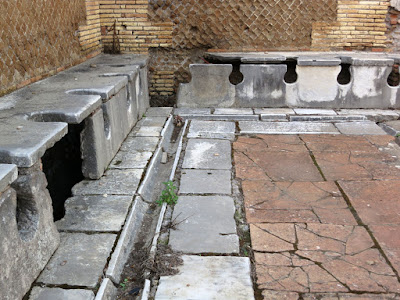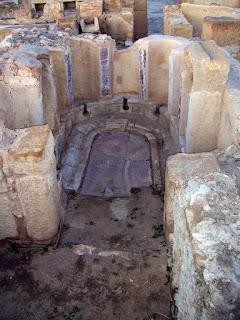RST is pleased to welcome back (her last post was in 2014, using her Etruscan specialty) guest blogger Theresa Potenza. Based in Rome, Potenza is an art historian and freelance writer. To learn more about her private tours of Rome and read her travel and feature stories about Italy, check out: www.tourwiththeresa.com.
There is no better place to be than Rome during the holidays. A city that is eternally enchanting becomes even more so during the magic of Christmastime. Whether you want to shop, eat, pray, or witness the great spectacles of holiday cheer, here is a list of what to do and where as 2018 comes to a close.
See
 |
| Picasso's sculpture in the Galleria Borghese. |
For other main attractions, most museums and archaeological
sites stay open through the holiday season, closing only on Christmas Day. The
Vatican, however, is closed both the 25th and 26th. All sites are free the last Sunday of every month; so you can enjoy entrance to
the Coliseum, the Vatican, and other major sites free of charge on Sunday
December 29th (although you might be fighting crowds then).
Eat
 |
| Roasted lamb with potatoes. |
 |
| Campagna Amica market, on via di San Teodoro, behind the Campidoglio (Capitoline Hill) and near Circus Maximus. |
Listen
With its Christmas fair and live concerts, the Auditorium Parco della Musica is the place to be. Their Gospel Festival running from
December 21st to December 31st is the most important
gospel festival in Europe, presenting some of the best gospel artists from the
United States. For a program of events, see their website, https://www.auditorium.com/.
 |
| Ice-skating at Parco della Musica. |
At 5 p.m. Thursday, December 20th, the Chorus from the University of Tor Vergata will give a Chrismtas concert of traditional songs at the Biblioteca Nazionale (Metro B).
If you’re interested in a day trip, Orvieto is a perfect
idea, just 2 hours by train from Rome. From December 28th through January 1st
the hilltop medieval town will be host to one of the world’s most famous music
festivals, Umbria Jazz - Winter, celebrating its 45th year. Past
performers include Miles Davis, Sting, Chet Baker and BB King. This year there
will be street parades, and a mixing of food with music with many places
featuring live concerts over lunch or dinner, highlighting the local cuisine
and a variety of jazz sounds including soul, funk, classical, and swing. For a
program of events see their website, http://www.umbriajazz.com.
 |
| Orvieto Winter Jazz |
Shop
One of the world’s most creative urban markets expands to 2
levels at Christmastime. Mercato Monti, open on weekends from
10am-8pm, is laden with products, all made in Italy. The market features local,
young and creative artisans, designers and innovators showcasing their handmade
jewelry, leather goods, shoes, clothes and beauty supplies. Located in
Rome’s “hipster” neighborhood, which also happens to be the city’s oldest,
makes it the best platform for "Made in Italy." The motto of Mercato Monti is “emancipate yourself from ordinary shopping,” which is perfect advice at Christmastime.
Pray
It always surprises me how solemn and peaceful Rome can be
amid the city’s hustle and bustle. It should be no surprise, however, that the
Vatican is impressive at Christmastime. Its life-size nativity scene in St. Peter’s
Square this year is uniquely made out of sand, from a beach in Venice. And
its decorated tree from Northern Italy is an impressive 23m (75 feet) tall. In addition to information on their Christmas Eve and Christmas Day masses and New Year’s Eve Te
Deum prayer and vespers, you can find out about Vatican celebrations and Papal
audiences during the holiday period online at the Vatican website,
www.vatican.va, under the
category of the prefecture of the Papal household.
 |
| One of the presepe or Nativity scenes on via della Conciliazione. |
Several churches in Rome offer masses and music in English, which you can celebrate in a variety of ways, such as traditional midnight mass,
carol service, and children’s pageants. Among the primary English language
churches are All Saints' Anglican Church, St. Paul’s Within the Walls Episcopal Church and St. Patrick’s American Roman Catholic Church.
Watch |
| Concert at St. Paul's Within the Walls Episcopal Church. |
Because Rome is a world capital, it's a great place to celebrate New Year's Eve. This year on New Year's Eve Rome is celebrating the 50th anniversary of the first lunar landing with 24 hours of events. In the Circus Maximus starting at 9 p.m. there will be a free outdoor event, a mix of "moon inspired" performers such as dancers, acrobats and an orchestra, culminating in a fireworks display at midnight. Another option is to ring in the New Year at the Baroque masterpiece fountain called "Il Fontanone" on the Janiculum Hill overlooking the city--a magical experience (and inexpensive).
And while most tourist sites may be closed on New Year's Day, hundreds of performers will continue the celebration throughout New Years's Day around the Aventine Hill and Tiber Island. Also on New Year's day, check out the parade of American marching bands that will perform throughout the city's historic center. The parade starts at 3:30 p.m. in Piazza del Popolo and lasts 2 and a half hours. Street performers, American high school marching bands and Italian folk singers will turn the Spanish Steps and surrounding area into their stage!
Theresa Potenza
P.S. For thumbnail descriptions of Christmas markets in Northern Italy, see Dianne Hales's post:
https://becomingitalianwordbyword.typepad.com/becomingitalian/2018/12/christmas-in-the-italian-language-seasonal-markets.html

























